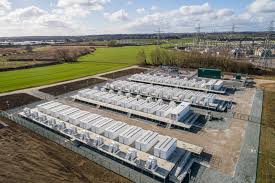Renewable energy generation, such as wind and solar power, is an important way to support low-carbon energy transformation and also a key measure to implement the “double carbon” goal. The Battery Energy Storage System (BESS) has the advantages of flexible operation mode, short construction cycle, and low environmental requirements. It can effectively restrain the power fluctuation of distributed energy generation and play an important supporting role in improving the stability of the power system with a high proportion of renewable energy generation. Battery Energy Storage System is generally composed of multiple Battery Energy Storage Units (BESUs), and each BESU is composed of a large number of single batteries.

Due to the influence of objective factors such as the uneven coating, composition, and impurity content during the battery manufacturing process, there are inherent differences in the same batch of the same type of batteries, resulting in inherent differences in the energy storage batteries when they are grouped at the factory. As the operating time progresses, these tiny differences will have a cumulative effect, leading to various types of inconsistencies within the BESU. When participating in the power regulation process of the microgrid, the BESU is often simplified as a large single battery, ignoring the internal characteristics of the BESU.
The inconsistency of the batteries inside the BESU will lead to a reduction in the actual available capacity of the BESU. Therefore, based on the internal characteristics of the energy storage unit, studying the balanced management and power distribution control strategy of the energy storage unit to improve the regulation ability of Battery Energy Storage System, extend the service life of Battery Energy Storage System, and improve the safety level of operation is the core, and it is also the key to promoting the continuous development of battery energy storage technology.
Based on the operating characteristics of lithium iron phosphate batteries, this paper studies the performance deterioration caused by the internal inconsistency of the BESU and the design of the system operation power control strategy when Battery Energy Storage System participates in the microgrid regulation. The main research contents are as follows:
- State estimation of lithium iron phosphate battery: The battery energy storage system is composed of a large number of single batteries, and the accurate estimation of its State of Health (SOH) and State of Charge (SOC) is the premise to realize the safe and stable operation of the energy storage system. This paper analyzes the working characteristics, SOC and SOH estimation methods of lithium iron phosphate batteries, and lays a theoretical foundation for the subsequent battery balance management method and Battery Energy Storage System optimal control strategy for the internal inconsistency of energy storage units.
- Research on the inconsistency of energy storage batteries: There are inherent differences between single cells after leaving the factory, and when they are operated in series and parallel groups, the inconsistency between groups will gradually intensify, directly affecting the available capacity and operation safety of energy storage units and even the whole Battery Energy Storage System. For the lithium-ion energy storage unit, this paper analyzes the causes and manifestations of inconsistency within the unit, studies the methods to improve the SOC consistency among batteries within the unit, selects the battery SOC balancing control architecture based on the auxiliary power, and proposes the battery pack small period balancing control strategy based on SOC. The simulation results show that the balancing topology and balancing policy can effectively improve the consistency between batteries and shorten the balancing time.
- BESS power distribution strategy considering internal state consistency of energy storage unit: Aiming at the inconsistency between SOH and SOC in the energy storage unit caused by the irregular charging and discharging of Battery Energy Storage System, this paper studies the relationship between the SOH difference in the energy storage unit and the SOC consistency. Based on the Adaptive Mutation Particle Swarm Optimization (AMPSO) algorithm, Battery Energy Storage System power allocation strategy considering the consistency of SOH and SOC is proposed. The proposed power distribution control strategy and the traditional power distribution control strategy are compared and simulated by using the measured data of the common DC bus type centralized microgrid grid-connection demonstration platform including BESS, wind/optical power generation, electric vehicle, and conventional load. The simulation results show that the proposed control strategy can effectively improve the consistency of the SOC of the energy storage unit, prolong the service life of the energy storage unit, reduce the operating loss of the energy storage unit, and enhance the bidirectional regulation ability of Battery Energy Storage System.
